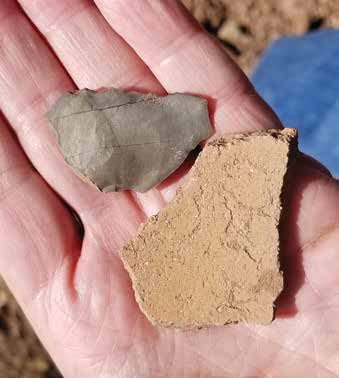The English-Harkey site lies in Lone Mountain Canyon, a few miles north of Carrizozo, New Mexico. The site, which was first recorded in 1973, is an early Jornada Mogollon settlement that dates to the little-known Corona Phase between A.D. 950 and 1000, when this region was scattered with small hamlets. Subsequently, people began to aggregate at larger sites and focus more intensively on agriculture.
In 1986, a team led by archaeologists Jane Kelley and Joe Stewart of the University of Calgary in Alberta, Canada, investigated the site, which is named after landowners Fred English and Howard Harkey of Carrizozo. The researchers defined the site boundaries, created a map, and proposed auger testing and excavations of portions of the site. In order to determine the nature, depth, and preservation of cultural deposits, the archaeologists conducted forty-nine auger tests within and outside of forty-three features. They also excavated two of these features as well as another area. The researchers’ principal objective was the recovery of faunal and botanical samples from these archaeological contexts, since such material has rarely been found intact at a Corona phase site.
Botanical analysis of the plant remains revealed charred corn, juniper seeds, pine bark fragments, and yucca seeds and pods. The faunal remains came from antelopes, rabbits, and rodents. Future research at the site will help to refine our understanding of the region’s chronology and the nature of subsistence strategies for this period during which people apparently did not practice intensive agriculture.
The site faced threats from modern development, looting, grazing, and erosion, and was listed for sale by the landowners. The Conservancy purchased the 19.5-acre lot containing the site for $15,000 with funds from the Point 6 Program, a fundraising campaign that generated funds for emergency acquisition of threatened sites. The site will be fenced and a long-term management plan will be created to address site security, stabilization, and access issues with input from adjacent landowners, the State Historic Preservation Division, and knowledgeable archaeologists.
Excerpt from an article published in American Archaeology, Summer 2018 | Vol. 22 No. 2.




